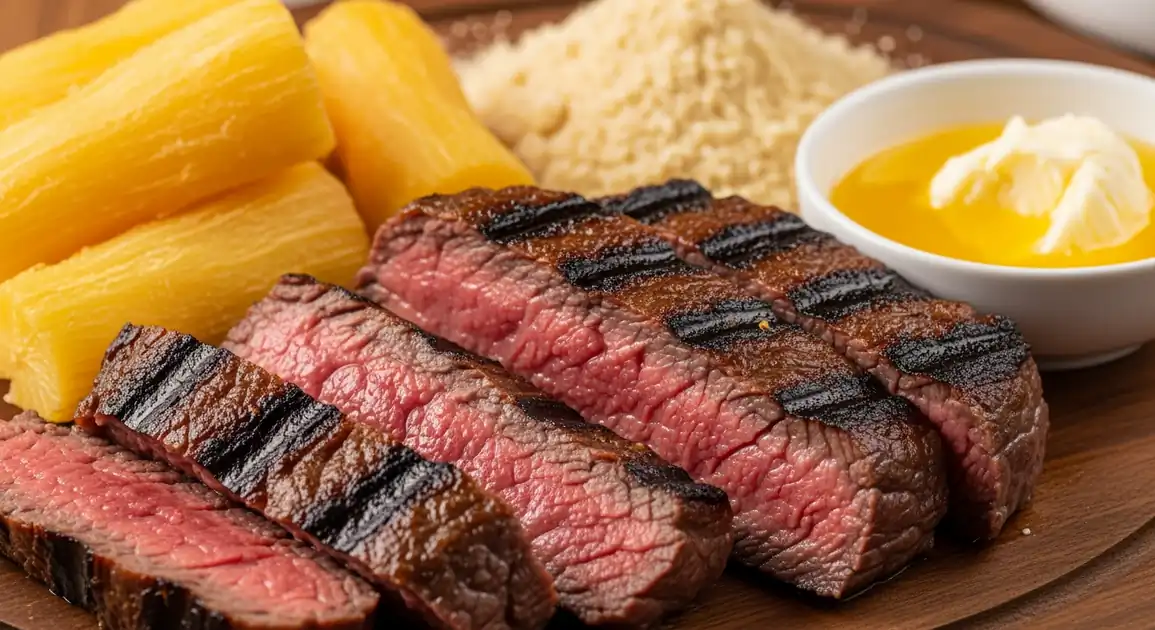Carne de Sol (Sun-Cured Beef)
Carne de Sol

Description
In Rio de Janeiro, Carne de Sol is primarily enjoyed thanks to the large community of migrants from the Northeast. The best place to find authentic versions is the Feira de São Cristóvão (Centro Luiz Gonzaga de Tradições Nordestinas), a large fair dedicated to Northeastern culture. Numerous Northeastern restaurants are also scattered throughout the city, particularly in the Zona Norte and Centro.
Dietary Information
Serving information
Serving style
Typically served as a large platter meant for sharing, with the grilled or fried meat surrounded by aipim (fried or boiled), farofa, manteiga de garrafa, rice, and beans.
Quick facts
Feira de São Cristóvão has extended hours, especially on weekends (often open late). Restaurants follow typical lunch/dinner schedules.
Safety Tips
What to Look For
-
Served piping hot
Ensures the meat is thoroughly cooked and safe to eat right after preparation.
-
Reputable Restaurant/Eatery
Choose places known for good quality Northeastern food or with positive hygiene ratings.
-
Meat looks properly cooked
Should have appropriate color for grilled/fried beef, indicating it's cooked through.
-
Fresh accompaniments
Sides like farofa, vinaigrette, and particularly the 'manteiga de garrafa' should look and smell fresh.
-
Clean dining environment
General cleanliness is a good indicator of overall hygiene standards.
What to avoid
-
Lukewarm or cold meat
Indicates improper holding temperature, posing a food safety risk.
-
Meat that appears undercooked
Beef should be cooked to a safe internal temperature.
-
Establishments with poor hygiene
Avoid places that seem unclean or have poor food handling practices.
-
Rancid 'manteiga de garrafa' or stale farofa
Accompaniments should be fresh; rancid butter can cause illness and stale farofa ruins the texture.
-
Overly dry or tough meat
While not necessarily unsafe, it indicates poor preparation or low-quality meat.
Price information
Price range
Budget tips
- Feira de São Cristóvão offers many options at varying, often competitive prices compared to standalone restaurants.
- Restaurants in Zona Norte might be more affordable than those in Zona Sul tourist areas.
- Sharing a portion is highly recommended due to large sizes.
Value indicators
- Restaurant explicitly promotes Northeastern cuisine.
- Served with classic accompaniments (aipim, farofa, manteiga de garrafa).
- Meat is tender and flavorful.
- Served hot and looks freshly prepared.
- Busy atmosphere, especially at the Feira.
Where to Find This Dish
Feira de São Cristóvão (São Cristóvão Neighborhood)
The absolute hotspot for Northeastern food and culture in Rio, with dozens of restaurants and stalls serving Carne de Sol.
Centro Luiz Gonzaga de Tradições Nordestinas
Weekend Evenings (Fri-Sun), Weekend Lunch
Zona Norte (North Zone)
Neighborhoods with significant Northeastern populations often have authentic and affordable restaurants.
Tijuca, Vila Isabel, Méier
Lunch, Dinner
Centro (Downtown)
Some traditional restaurants or those catering to workers might offer Carne de Sol, especially for lunch.
Near Carioca station, Saara market vicinity
Lunchtime
Vendor Tips
- A visit to Feira de São Cristóvão is highly recommended for the full cultural and culinary experience.
- Go hungry – portions are usually very generous.
- Confirm what sides are included with the 'porção' (portion).
- Be prepared for a lively, noisy atmosphere at the Feira.
How to Order
Regional Variations
-
Carioca Restaurant Interpretations
(Interpretações de Restaurantes Cariocas)
Some non-specialized Rio restaurants might offer a version, but authenticity of curing and accompaniments might vary compared to dedicated Nordestino spots.
Cultural context
History
The origins of Carne de Sol are deeply rooted in the 'sertão' (arid backcountry) of Northeastern Brazil, dating back to colonial times. It emerged as a vital method for preserving beef in a hot climate before refrigeration, allowing cattle ranchers ('vaqueiros') and sertanejos to conserve meat for longer periods. The technique involves light salting and utilizing the dry air and sun for dehydration. Carne de Sol became a staple food and cultural symbol of the Nordeste, eventually spreading in popularity throughout Brazil.
Local significance
Represents the significant cultural and culinary contribution of the Northeastern diaspora to Rio de Janeiro's identity. A taste of the 'Nordeste' in Rio.
Eating customs
- Sharing platters amongst friends and family is the norm.
- Generous application of 'manteiga de garrafa' is encouraged.
- Enjoying the hearty combination of flavors and textures.